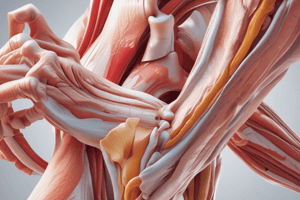Podcast
Questions and Answers
What is the term for movement away from the vertical midline?
What is the term for movement away from the vertical midline?
- Adduction
- Abduction (correct)
- Extension
- Flexion
What does adduction refer to?
What does adduction refer to?
- Movement away from the midline
- Act of bending
- Turning inwards
- Movement towards the midline (correct)
What is flexion?
What is flexion?
Act of bending or being bent
What is extension?
What is extension?
What does dorsiflexion refer to?
What does dorsiflexion refer to?
What is plantar flexion?
What is plantar flexion?
What does eversion mean?
What does eversion mean?
What is inversion?
What is inversion?
What does pronation refer to?
What does pronation refer to?
What is supination?
What is supination?
What does elevation refer to?
What does elevation refer to?
What is depression in terms of body movement?
What is depression in terms of body movement?
What does circumduction mean?
What does circumduction mean?
What is opposition?
What is opposition?
What does rotation refer to?
What does rotation refer to?
Flashcards are hidden until you start studying
Study Notes
Muscle Movement Terms
-
Abduction: Movement that takes a limb away from the body's midline, crucial for actions like lifting arms sideways.
-
Adduction: Movement that brings a limb closer to the midline, important for actions like crossing arms or legs.
-
Flexion: The process of bending a limb, decreasing the angle between two body parts, such as bending the elbow.
-
Extension: The act of straightening a limb, increasing the angle between body parts, like straightening the elbow.
-
Dorsiflexion: Bending the foot backwards towards the shin, important for walking and balancing.
-
Plantar Flexion: Pointing the foot downward, which is significant for actions like standing on tiptoes or pushing off during walking.
-
Eversion: The movement where the sole of the foot turns outward, relevant for maintaining balance on uneven surfaces.
-
Inversion: The movement where the sole of the foot turns inward, often involved in stability during physical activities.
-
Pronation: The action of turning the foot or hand downwards or backwards, essential for certain movements like throwing.
-
Supination: The act of turning the foot or hand upwards, used in actions such as holding a bowl of soup.
-
Elevation: Lifting a body part, such as shrugging shoulders, important for various arm movements.
-
Depression: Lowering a body part, like relaxing shoulders, which aids in restoring posture.
-
Circumduction: Circular movement at a joint, resulting in a cone-like motion, such as moving the arm in a circular path.
-
Opposition: The unique movement of the thumb moving away from the palm, allowing for gripping and grasping objects.
-
Rotation: The turning of a body part around its central axis, such as rotating the head from side to side.
Studying That Suits You
Use AI to generate personalized quizzes and flashcards to suit your learning preferences.




